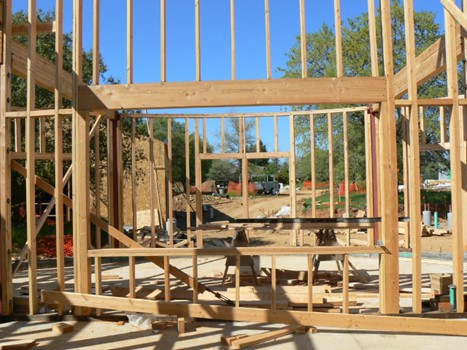Recent decision out of the Tennessee Court of Appeals offers cautionary tale for Tennessee homebuilders.
In Garrett v. Hidden Valley Homes, LLC, No. M2022-015310-COA-R3-CV, 2023 LEXIS 426 (Tenn. Ct. App. Aug. 22, 2023), the Tennessee Court of Appeals upheld the Trial Court’s ruling that complying with Codes may not be enough to avoid liability for defective construction, offering a cautionary tale to Tennessee homebuilders.
Background:
A dispute arose between the buyer, sellers, and builder of a home in Brentwood, Tennessee. The residence was built in 2012, and the builder’s owners (the “Sellers”) lived in the home for approximately four years before conveying the property to the Plaintiff in 2016. Four months after moving in, the buyer began noticing issues with the marble flooring, including visible cracks, sloping, a noticeable hump, and a “noticeable bounce” in the floor. The buyer (the “Plaintiff”) sued both the Builder limited liability company and the individual Sellers, alleging a breach of the implied warranty of good workmanship and materials, negligent construction, breach of the Tennessee Consumer Protection Act, failure to disclose material facts, fraudulent misrepresentation, and a claim to pierce the corporate veil.
At trial, two expert witnesses testified on behalf of the Plaintiff. The Plaintiff’s engineering expert testified that the problems with the flooring were caused by “over-spanned” I-joists which, while compliant with local code, did not satisfy the installation recommendations of the Marble Institute of America. He proposed a method of repair which involved fixing the tiles from beneath. However, he admitted this method of repair would be difficult and he did not provide any recommendations as to the costs of such recommended repair.
The Defendants’ engineering expert agreed that the conditions did not conform to Marble Institute of America criteria. However, the defense expert opined that while the method of repair proposed by the Plaintiff’s engineering expert engineer would not adversely affect the flooring, it was not necessary according to local residential code. The Defendants’ engineering expert opined that the hump could be lessened by removing two piers, but that while creating a flatter surface, such method could lead to further damage. He also did not provide any opinion as to the costs of repair.
The Plaintiff’s contractor testified that although the flooring met code requirements, the floor was not constructed in a workmanlike manner. He reasoned that the floor framing may have been adequate for hardwood floor but not for heavy marble tile like what was installed in the Plaintiff’s home. He recommended a method of repair that included removing and relaying the marble flooring and estimated a $77,494.36 total cost of repairs.
Based on the testimony of the Plaintiff’s contractor expert, the Trial Court concluded the Defendants breached the implied warranty of workmanlike construction and found the builder negligently constructed the residence. The Trial Court awarded the buyer $77,494.36 in damages for the repair costs, along with $47,758.02 in attorney’s fees (based on the Purchase and Sale Agreement’s prevailing party attorney’s fees provision), and $6,160.77 in discretionary costs, for a total judgement of $131,413.15. The Plaintiff also prevailed on her duty to disclose/fraudulent concealment. The Court found the Sellers liable for intentional misrepresentation and pierced the corporate veil, holding the Defendants (both the Builder and its owners, who sold the Property) jointly and severally liable.
The Defendants appealed, arguing that the Trial Court erred in adopting the Plaintiff’s expert testimony. The parties agreed the proper measure of damages is the cost of repairing the defects but disputed the method of repair and its cost. The Defendants further contended that the Trial Court improperly shifted the burden of proof from the Plaintiff to the Defendants to provide evidence regarding the cost of remediation using the methods of Plaintiff’s experts.
Tennessee Court of Appeals Holding:
The Tennessee Court of Appeals affirmed the Trial Court’s judgement in full. The Court noted that the implied warranty of good workmanship and materials requires a method of repair that addresses the defects in a manner consistent with the construction standards of homes in comparable locations and price ranges. The Trial Court found that the Plaintiff’s contractor expert’s testimony credible based on his familiarity with local construction practices and testimony directly relevant to that standard. Additionally, the Trial Court found that the Plaintiff’s contractor expert was the only expert to offer a comprehensive repair plan that would restore the property to a condition that would meet the standards of trade along with the costs of such repairs. The Court of Appeals agreed that the Plaintiff proved her damages based on her contractor expert’s testimony, on which the Trial Court properly relied.
The Tennessee Court of Appeals also rejected the Defendants’ argument that the burden of proof had been improperly shifted. The Court found that while it’s true that the Plaintiff bore the burden of proving her damages, she met this burden through her expert’s testimony and cost estimate, and the Trial Court was entitled to rely on that evidence.
What’s the takeaway?
In a cautionary tale to Tennessee contractors, the Tennessee Court of Appeals upheld the Trial Court’s ruling that complying with Codes may not be enough to avoid liability for defective construction. This means ensuring their work is not only Codes-compliant, but also meets the standard of the trade and what is considered “workmanlike” for homes in comparable locations and price range.
Photo Credit: Nick Ares licensed under CC BY-SA 2.0





